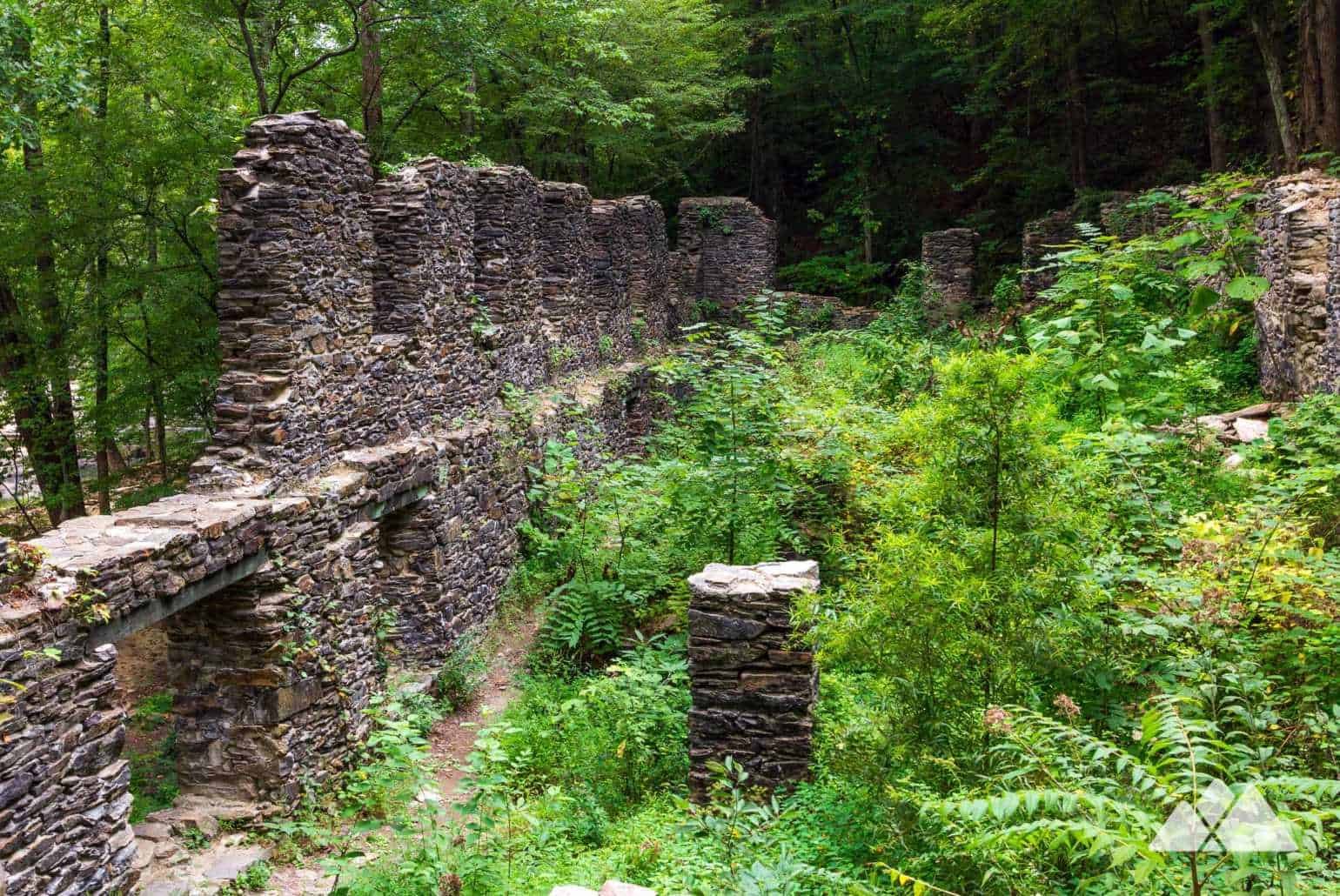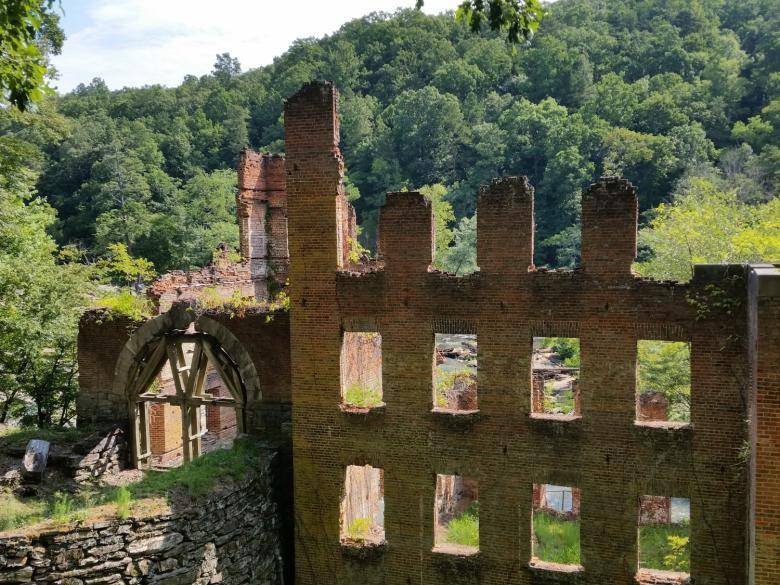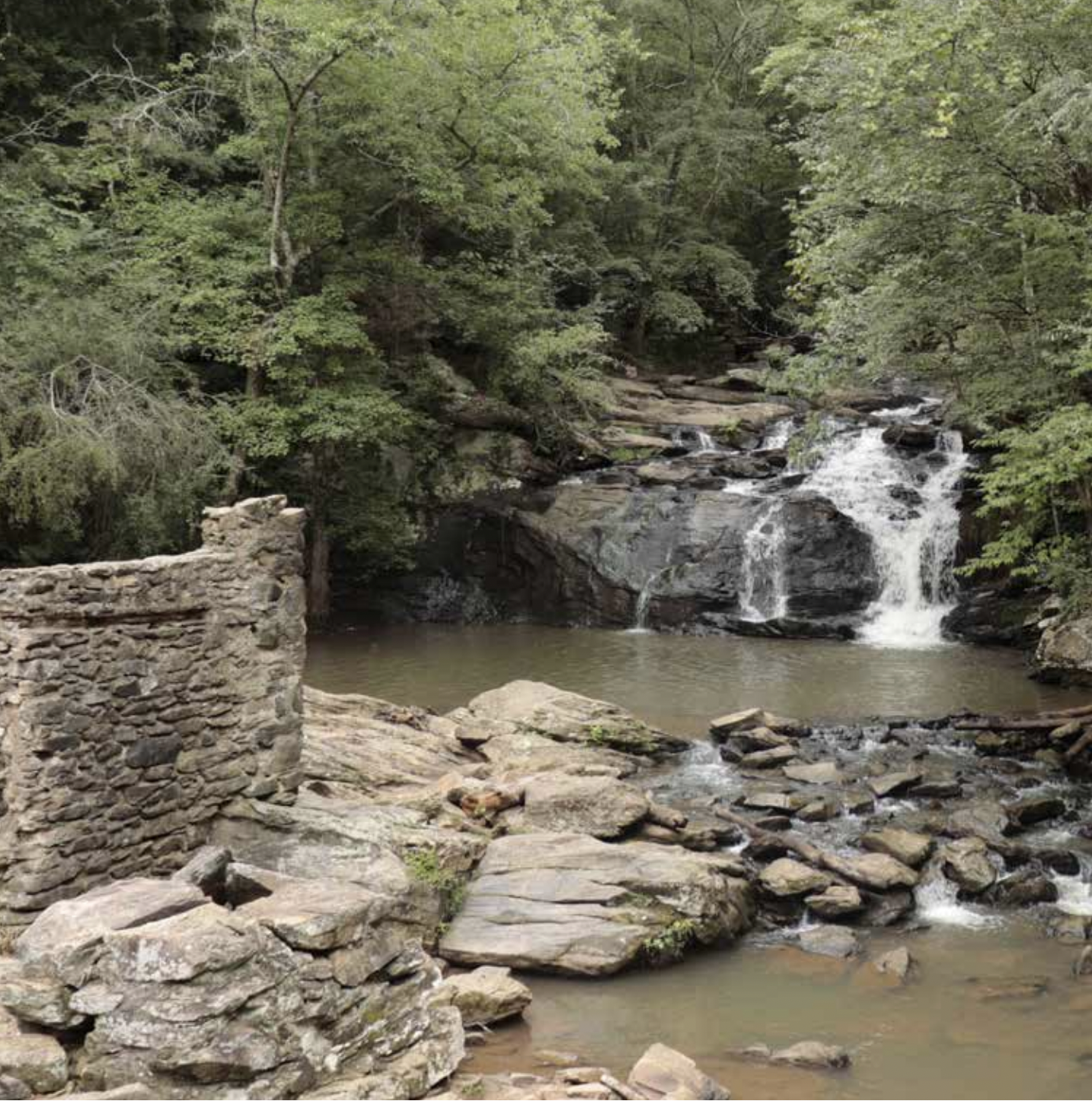New Trails and Old Ruins
Is there a future for the Flint headwaters’ past?
Photo by Stacy Funderburke, 2020.
When a Facebook follower commented that the ruins of Lee’s Mill were still standing by the Flint River, I didn’t believe it. I’ve been exploring these headwaters for a couple years with engineers and biologists and local experts and we had never encountered anything that looked like an old mill. Ghost roads and washed out bridges, yes. Even what looked like the remains of an old moonshine still! But a pre-civil war era building in the shadow of the airport? In a totally industrialized landscape that floods violently several times a year? Not a chance.
You can still see it on satellite images, this reader assured me, right where Lee’s Mill Road crosses the river. Sure enough, I found the curious outline of a structure on Google Maps and a roadside historical marker upstream on Forest Parkway for “Thames House.”
Res. of Wm. Thames (1796-1892) pioneer citizen of Clayton, formerly Henry, County; veteran of the War of 1812; owner of a saw & grist mill on Flint River; pastor of Tanner’s Church.
Was this the mill? There was a photo of Lee’s Mill in the Atlanta History Center archive, a battered old structure circa 1946… could there be anything left of it?
Photo by Wilbur D. Kurtz, November 1946, from the Kenan Research Center at the Atlanta History Center. Kurtz was a historian and artist who captured photos of old buildings around Clayton County from 1913 through the ‘40s. He worked as a production advisor on MGM films including Gone With the Wind.
Lee's Mill was owned and operated by a Clayton County pioneer family up until the death of W.L. Lee (1857-1933). Lee's obituary states that he served as the county surveyor and that "Mr. Lee's father built the old mill before the War Between the States and it is one of the landmarks in the county."
In August 2020, I got permission from the property owner to explore the ruins of Lee’s Mill. The plant managers at Luck Stone, the Virginia-based company that recently bought the land, were really nice about it, even curious to see what treasures were hidden out beyond their quarries. I invited photographer Virginie Kippelen to document the trip. Taking photos of the ruins and posting them online felt like an act of preservation.
Lee’s Mill Road was dusty with dump trucks speeding to and from the quarries. There was no sidewalk on the road, no shoulder, and if you tried to slow down to look past the thick kudzu, you would get sandblasted by a Mack truck hauling gravel.
That sweltering morning, we prepared for a trek into the wilderness, but Lee’s Mill was hidden in plain sight. We pawed through the privet, stepped over a few dumped tires, and the abandoned building was just yards from the busy road, its crumbling concrete and stone walls draped in English ivy and trumpet vine. We stepped inside cautiously.
Of course, we weren’t the first urban explorers to find it. Inside were some pallets, an old spring mattress, a ladder to the second floor, faded graffiti. Green river light glimmered on the board formed concrete walls.
We clambered down to the water and balanced across the scattered stones that once dammed the millpond. From the river, it looked like one corner of the building was teetering on a pillar of stones. The kudzu walls were so thick that river noise hid the sound of dump trucks gunning it up the hill.
We poked around for a while taking photos, picking up old tools and marveling what was left of the mossy stone walls. How was it still standing after 170+ years? How much longer would it last? Afterwards, I felt lucky to have seen the place. One more storm/flood could wash it away. Oh well.
Items gathered at Lee’s Mill, installed as part of Hartsfield-Jackson Atlanta International Airport’s City as Site exhibit.
I returned to Lee’s Mill this March. (Again, with permission and an escort. Don’t trespass, kids!) I was gathering materials for an exhibit at the airport. I wanted to include an artifact from the mill along with the animal bones, fur, feathers, scat, and airport litter I had collected from my riverside hikes. Placing these remnants in a display case in Concourse E felt like another small act of preservation.
I was amazed by the ruins all over again. The early spring foliage didn’t yet swallow the old building with overgrowth. I swear a few more stones had tumbled into the Flint since our last visit.
Lee’s Mill is one of the most remarkable sites along the Flint River, or any river in Atlanta. It’s a window into the rural past in an area that almost everyone (including me) had dismissed as an industrial wasteland. It’s cool and creepy, nostalgic and stately, quietly disintegrating in obscurity. I found a rusty valve wheel and a wrench to include in the exhibit, but wanted to share so much more.
The mill ruins in March 2022.
Why stop at these gestures towards preservation? Why not save what’s left of Lee’s Mill for the next generation to discover?
I started thinking of examples of other creekside ruins around Atlanta. New Manchester Manufacturing Company at Sweetwater Creek State Park, the beautiful old Marietta Paper Mill at Sope Creek Trail—both mills were destroyed during the Civil War and are now accessible by trail. The ruins of the Decatur Waterworks, coated with layers of graffiti, were my favorite part of South Peachtree Creek Trail.
None of these mills are stable or safe for picnics and field trips. Climbing on them or staging your engagement photos there is discouraged with signage and probably punishable by law. But these beautiful ruins are still an attraction that works because they are in big parks near nice residential areas.
Meanwhile, Lee’s Mill is this lonely remnant surrounded by rock quarries, highways, and the world’s busiest airport. Is it worth preserving?
The thrill of finding the mill and sharing it with others is a clue that, yes, there’s something special here. What if Lee’s Mill wasn’t just a dim memory or a secret hideout, but an episode along the Flint River Trail? I tried to map a trail along the sewer lines that follow the river, imagining what the trail would connect along the 2 miles between I-285 and Lee’s Mill Road. But there’s not much reason to go there, unless you work in the area. The mill is the reason, the trail is the destination.
You’ll go there to escape the noise and velocity of this industrial landscape, to see a wild and rushing river in the middle of it all. You’ll pause by the boulders and stone shoals and notice the tracks along the animal freeway running parallel to the trail. You’ll study the astonishing masonry of a 19th Century gristmill and maybe even older remnants of the Muscogee (Creek) stone fish traps. Hopefully, you’ll see the value of this forgotten stretch of the river, a place rich with history and wildlife and possibilities.








